Abstract
Antibodies against mumps virus have been studied by using immunoglobulin class-specific indicators labeled with 125I in the radioimmunoassay (RIA) procedure. The immunoglobulins in paired acute and convalescent sera were allowed to react with mumps virus in a solid-phase RIA system. Class-specific immunoglobulin indicators (anti-immunoglobulin M [IgM] and anti-immunoglobulin G [IgG]) labeled with 125I revealed that immunoglobulins of early antisera were preponderantly IgM, whereas immunoglobulins of late antisera were predominantly IgG. These indicators detected antibodies of the early (IgM) and late (IgG) phases of the immune response. These findings are consistent with the classical temporal order of appearance of 19s (IgM) and 7s (IgG) globulins. Specificity of these indicators for reacting with fractionated 7s and 19s globulins is also presented. Mumps virus RIA obtained with anti-IgG correlated well with conventional serological data obtained by neutralization and hemagglutination inhibition, but most strongly with complement-fixation data. In addition, antibody bound by solid phase was capable of distinguishing between related antigens of the myxovirus group.
Full text
PDF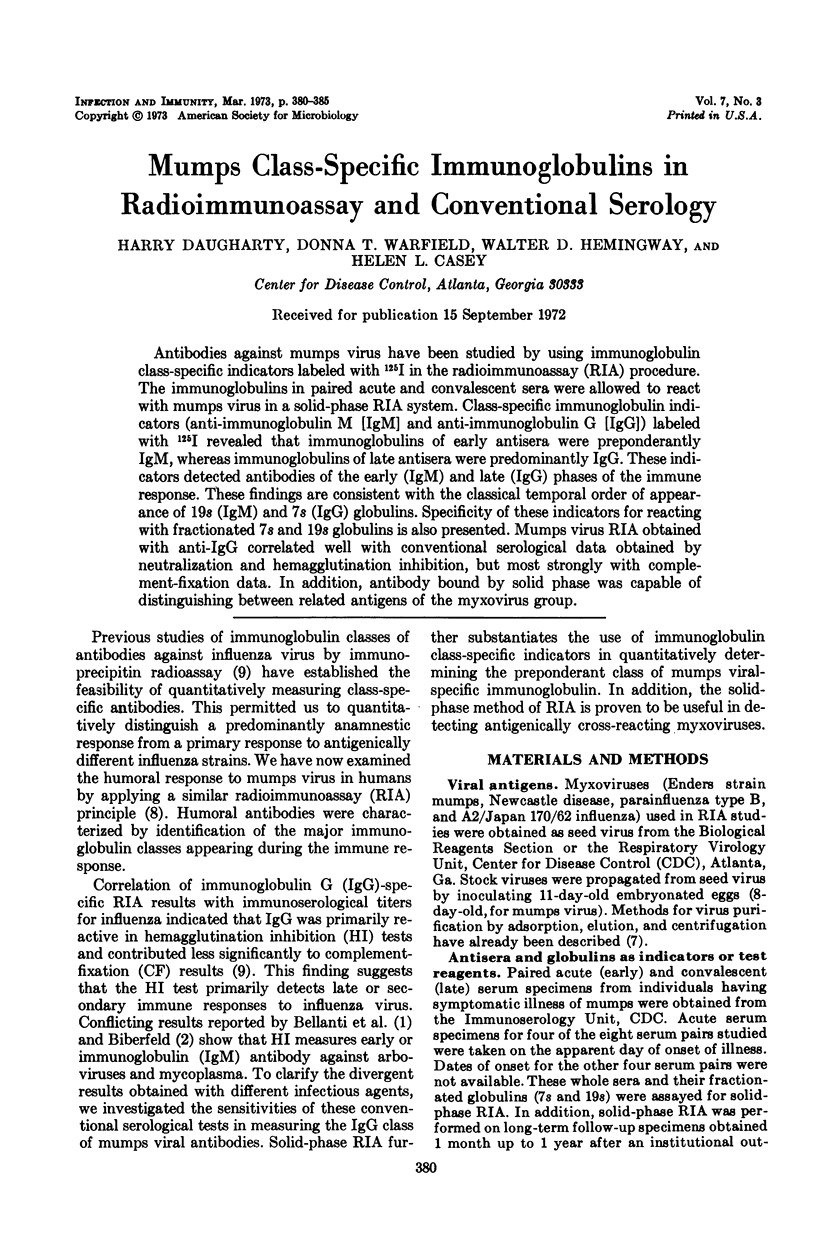
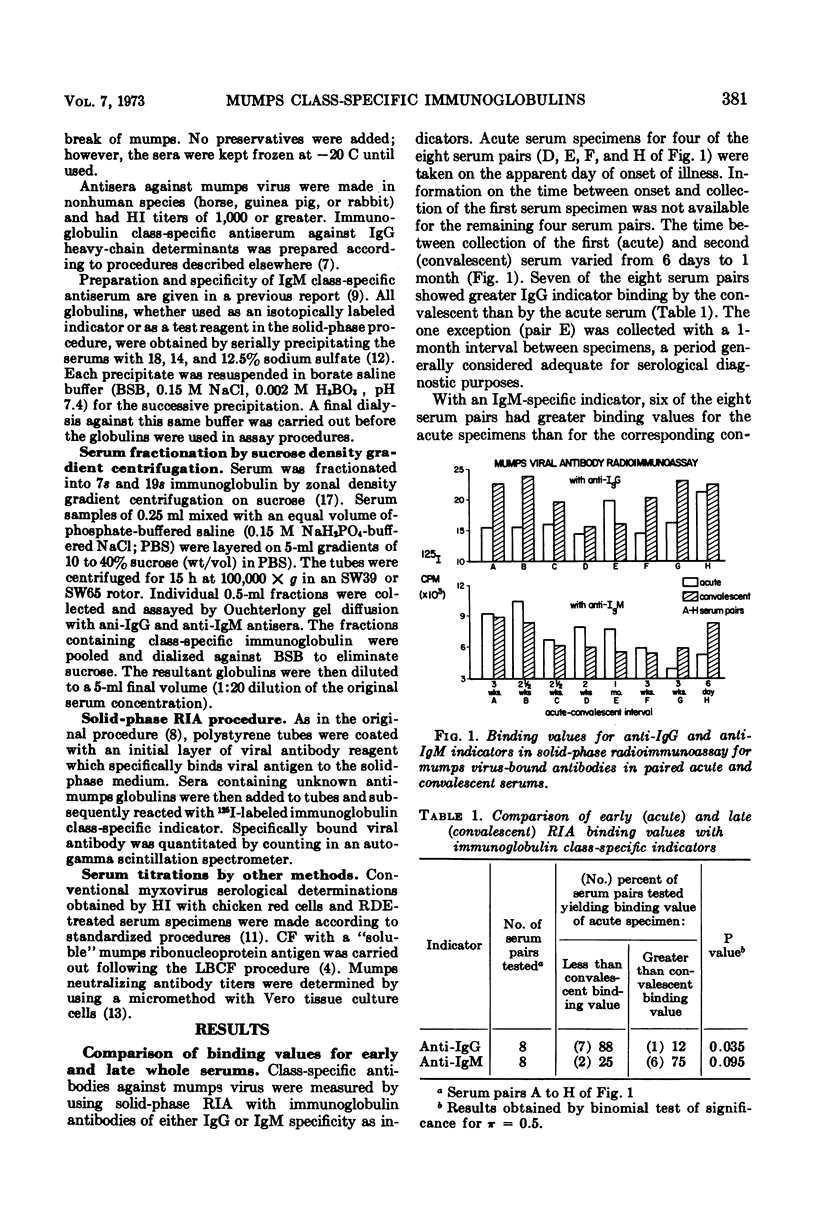
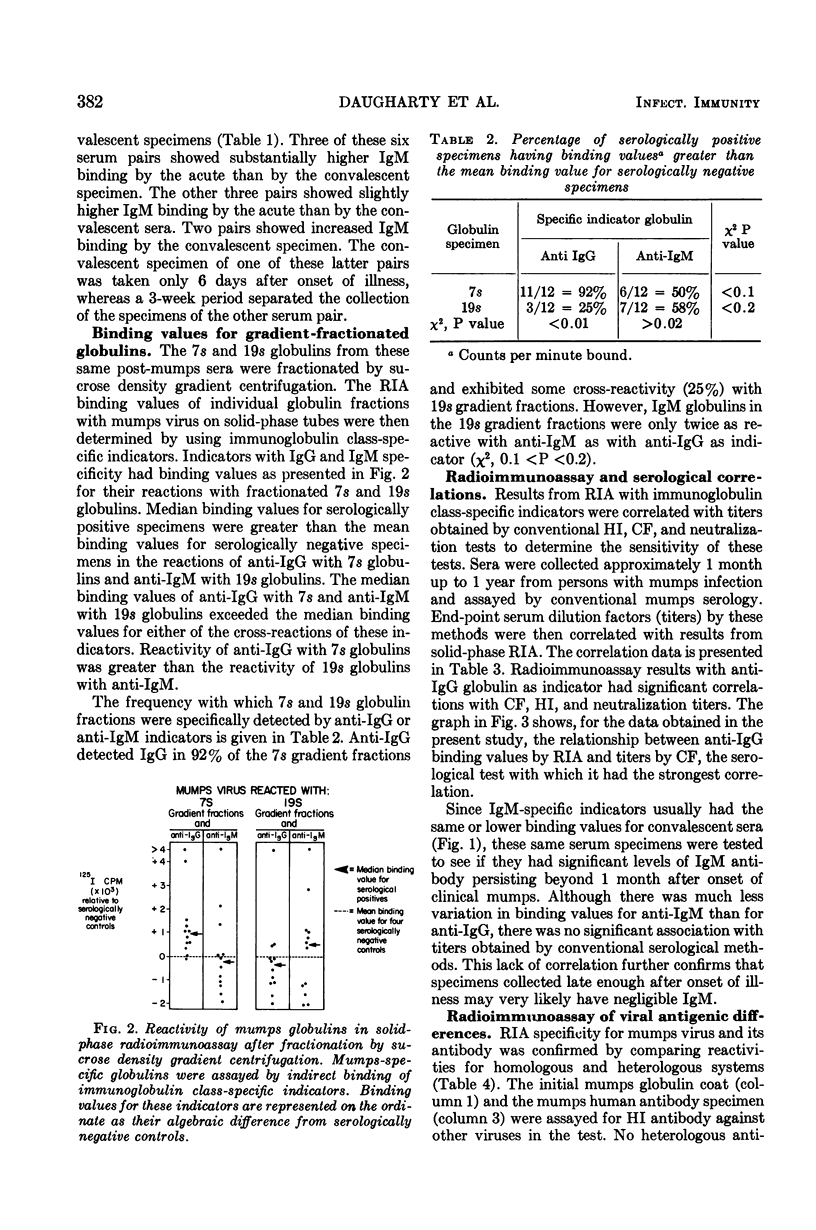
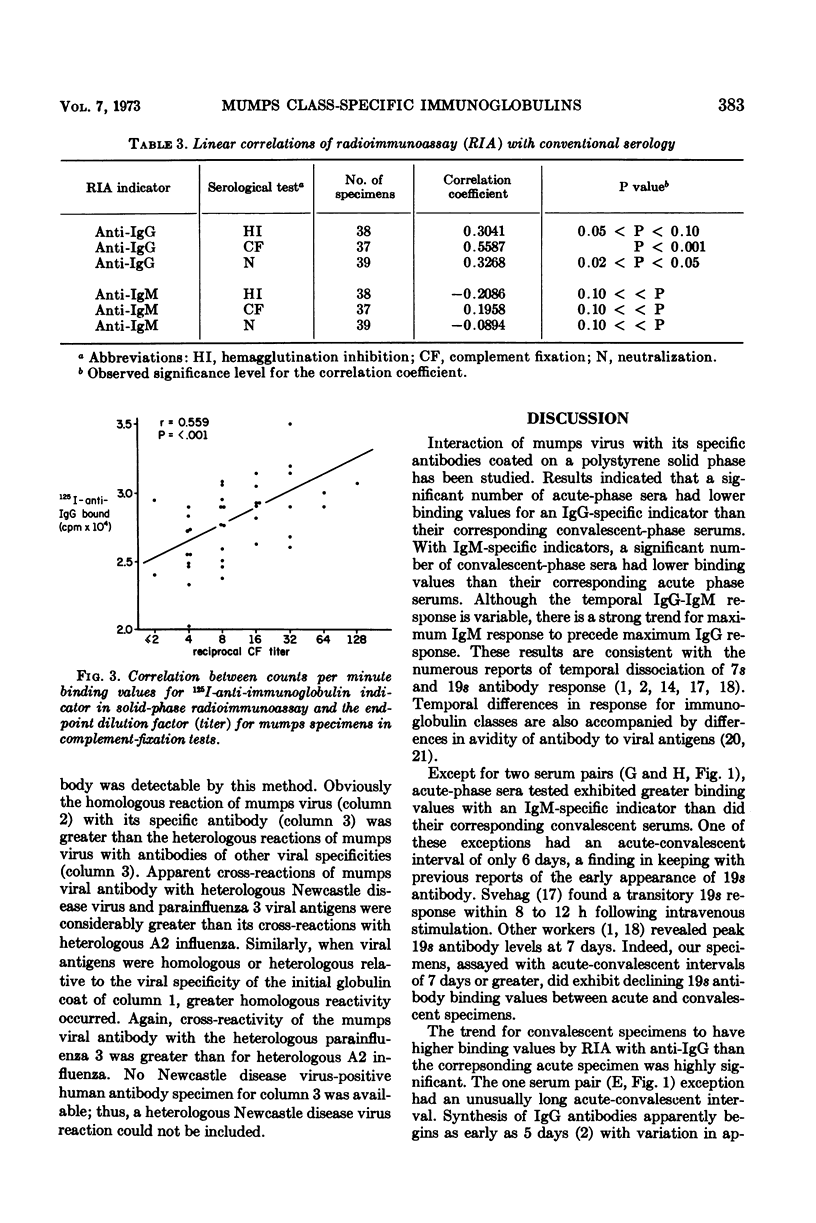
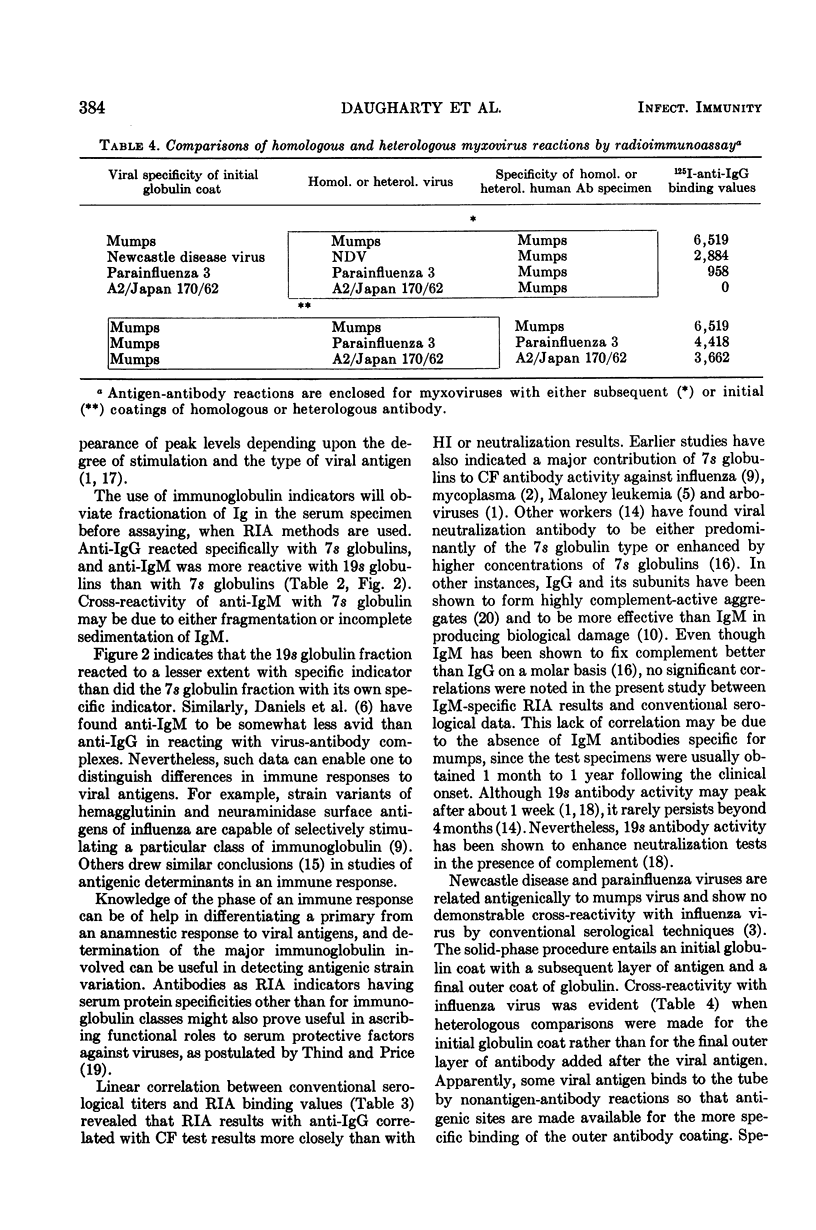
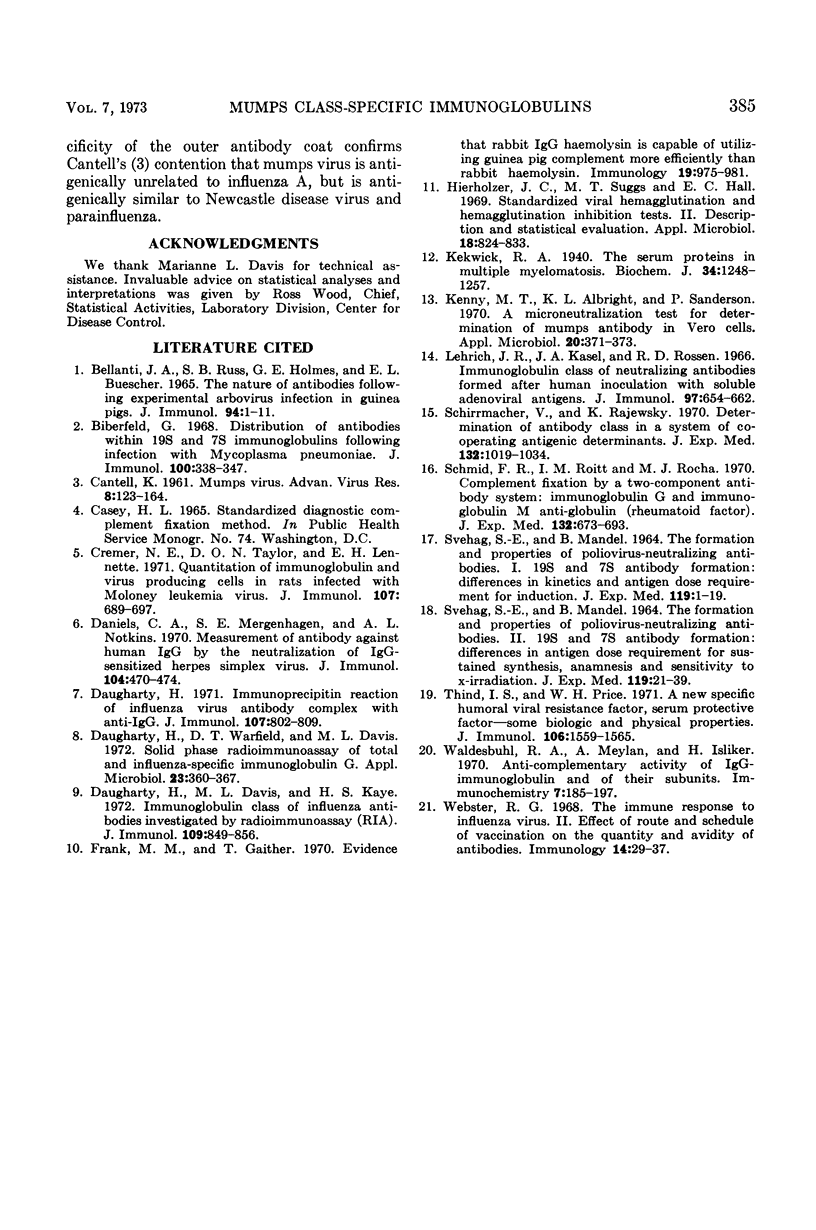
Selected References
These references are in PubMed. This may not be the complete list of references from this article.
- BELLANTI J. A., RUSS S. B., HOLMES G. E., BUESCHER E. L. THE NATURE OF ANTIBODIES FOLLOWING EXPERIMENTAL ARBOVIRUS INFECTION IN GUINEA PIGS. J Immunol. 1965 Jan;94:1–11. [PubMed] [Google Scholar]
- Biberfeld G. Distribution of antibodies within 19 S and 7 S immunoglobulins following infection with Mycoplasma pneumoniae. J Immunol. 1968 Feb;100(2):338–347. [PubMed] [Google Scholar]
- CANTELL K. Mumps virus. Adv Virus Res. 1961;8:123–164. doi: 10.1016/s0065-3527(08)60684-3. [DOI] [PubMed] [Google Scholar]
- Cremer N. E., Taylor D. O., Lennette E. H. Quantitation of immunoglobulin- and virus-producing cells in rats infected with Moloney leukemia virus. J Immunol. 1971 Sep;107(3):689–697. [PubMed] [Google Scholar]
- Daniels C. A., Mergenhagen S. E., Notkins A. L. Measurement of antibody against human IgG by the neutralization of IgG-sensitized herpes simplex virus. J Immunol. 1970 Feb;104(2):470–474. [PubMed] [Google Scholar]
- Daugharty H., Davis M. L., Kaye H. S. Immunoglobulin class of influenza antibodies investigated by radioimmunoassay (RIA). J Immunol. 1972 Oct;109(4):849–856. [PubMed] [Google Scholar]
- Daugharty H. Immunoprecipitin reaction of influenza virus-antibody complex with anti-IgG. J Immunol. 1971 Sep;107(3):802–809. [PubMed] [Google Scholar]
- Daugharty H., Warfield D. T., Davis M. L. Solid-phase radioimmunoassay of total and influenza-specific immunoglobulin G. Appl Microbiol. 1972 Feb;23(2):360–367. doi: 10.1128/am.23.2.360-367.1972. [DOI] [PMC free article] [PubMed] [Google Scholar]
- Frank M. M., Gaither T. Evidence that rabbit gamma G haemolysin in capable of utilizing guinea-pig complement more efficiently than rabbit gamma M haemolysin. Immunology. 1970 Dec;19(6):975–981. [PMC free article] [PubMed] [Google Scholar]
- Hierholzer J. C., Suggs M. T., Hall E. C. Standardized viral hemagglutination and hemagglutination-inhibition tests. II. Description and statistical evaluation. Appl Microbiol. 1969 Nov;18(5):824–833. doi: 10.1128/am.18.5.824-833.1969. [DOI] [PMC free article] [PubMed] [Google Scholar]
- Kekwick R. A. The serum proteins in multiple myelomatosis. Biochem J. 1940 Sep;34(8-9):1248–1257. doi: 10.1042/bj0341248. [DOI] [PMC free article] [PubMed] [Google Scholar]
- Kenny M. T., Albright K. L., Sanderson R. P. Microneutralization test for the determination of mumps antibody in vero cells. Appl Microbiol. 1970 Sep;20(3):371–373. doi: 10.1128/am.20.3.371-373.1970. [DOI] [PMC free article] [PubMed] [Google Scholar]
- Lehrich J. R., Kasel J. A., Rossen R. D. Immunoglobulin classes of neutralizing antibody formed after human inoculation with soluble adenoviral antigens. J Immunol. 1966 Nov;97(5):654–662. [PubMed] [Google Scholar]
- SVEHAG S. E., MANDEL B. THE FORMATION AND PROPERTIES OF POLIOVIRUS-NEUTRALIZING ANTIBODY. I. 19S AND 7S ANTIBODY FORMATION: DIFFERENCES IN KINETICS AND ANTIGEN DOSE REQUIREMENT FOR INDUCTION. J Exp Med. 1964 Jan 1;119:1–19. doi: 10.1084/jem.119.1.1. [DOI] [PMC free article] [PubMed] [Google Scholar]
- SVEHAG S. E., MANDEL B. THE FORMATION AND PROPERTIES OF POLIOVIRUS-NEUTRALIZING ANTIBODY. II. 19S AND 7S ANTIBODY FORMATION: DIFFERENCES IN ANTIGEN DOSE REQUIREMENT FOR SUSTAINED SYNTHESIS, ANAMNESIS, AND SENSITIVITY TO X-IRRADIATION. J Exp Med. 1964 Jan 1;119:21–39. doi: 10.1084/jem.119.1.21. [DOI] [PMC free article] [PubMed] [Google Scholar]
- Schirrmacher V., Rajewsky K. Determination of antibody class in a system of cooperating antigenic determinants. J Exp Med. 1970 Nov;132(5):1019–1034. doi: 10.1084/jem.132.5.1019. [DOI] [PMC free article] [PubMed] [Google Scholar]
- Schmid F. R., Roitt I. M., Rocha M. J. Complement fixation by a two-component antibody system: immunoglobulin G and immunoglobulin M anti-globulin (rheumatoid factor). Parodoxical effect related to immunoglobulin G concentration. J Exp Med. 1970 Oct 1;132(4):673–693. doi: 10.1084/jem.132.4.673. [DOI] [PMC free article] [PubMed] [Google Scholar]
- Thind I. S., Price W. H. A new specific humoral viral resistance factor, serum protective factor--some biologic and physical properties. J Immunol. 1971 Jun;106(6):1559–1565. [PubMed] [Google Scholar]
- Waldesbuhl M., Allan R., Meylan A., Isliker H. Anticomplementary activity of gamma G-immunoglobulins and of their subunits. Immunochemistry. 1970 Feb;7(2):185–197. doi: 10.1016/0019-2791(70)90154-0. [DOI] [PubMed] [Google Scholar]
- Webster R. G. The immune response to influenza virus. II. Effect of the route and schedule of vaccination on the quantity and avidity of antibodies. Immunology. 1968 Jan;14(1):29–37. [PMC free article] [PubMed] [Google Scholar]


